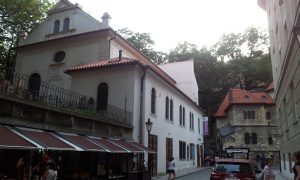The Klausen Synagogue in Prague’s Jewish Town
By Tracy A. Burns
The construction of the Klausen Synagogue
 Built when Renaissance architecture flourished in the Jewish Town during the 16th century, the Klausen Synagogue near the Old Jewish Cemetery was named after the Latin “claustrum,” which means “small building.” Wealthy businessman and mayor of the Jewish Town, Mordechai Maisel, who also built his own synagogue, had the Klausen Synagogue erected in honor of Emperor Maximilian II’s visit to the quarter in 1573.
Built when Renaissance architecture flourished in the Jewish Town during the 16th century, the Klausen Synagogue near the Old Jewish Cemetery was named after the Latin “claustrum,” which means “small building.” Wealthy businessman and mayor of the Jewish Town, Mordechai Maisel, who also built his own synagogue, had the Klausen Synagogue erected in honor of Emperor Maximilian II’s visit to the quarter in 1573.
The three buildings and the fire of 1689
The synagogue was situated in a dangerous, decrepit neighborhood and initially consisted of three buildings. One structure was used for religious services, another comprised a hospital and ritual bath, and the third was a Talmud school where, during the 16th century, the renowned Rabbi Loew taught. (According to legend, Rabbi Loew created the clay artificial figure of the Golem, who was supposed to defend the Jewish Town against anti-Semitic attacks.) Unfortunately, tragedy struck, and the buildings were swallowed up by flames during the very destructive 1689 fire that damaged most of the synagogues and destroyed all 318 homes in the Jewish quarter.
Reconstruction in the late 17th century
The synagogue was rebuilt as the New Klausen School thanks to Solomon Chalish Kohen. Its makeover was complete in 1694. During its golden age, the Klausen Synagogue was one of the largest structures in the Jewish Town as well as the second most popular synagogue. Also, the Prague Burial Society used this house of prayer. The entranceway portal bore the inscription, “This is the gate to the Lord through which the just enter.” In 1696 a Holy Ark fashioned in Baroque style was built along the eastern wall. It has three tiers and is made of wood and artificial marble. It also consists of tablets of the Decalogue, which stands for the Torah. A shell-shaped Baroque marble alms box still decorates the vestibule, too.
The current appearance of the Klausen Synagogue
The house of prayer got its current appearance during reconstruction at the end of the 19th century. The main nave and the women’s gallery were enlarged. The staircase and façade also underwent repairs. Stucco décor was added, too, as motifs of ribbons and fruit decorate the barrel vault. Stained glass adorned with the Star of David was added to the windows. The façade was also rebuilt. Pews lined the walls.
The synagogue’s history from World War II to the present
The Klausen Synagogue served as a storage facility during World War II, but most of the interior was destroyed by the Nazis. An exhibition featuring ritual artifacts was set up during the war. Renovations took place in 1960, 1979 to 1981, and 1983. In the early 1980s, the synagogue showcased an exposition of Hebrew manuscripts and prints. After the 1995 and 1996 reconstruction, an exposition of Jewish festivals, customs, and traditions was installed in the synagogue.
The displays of the current exposition
The Baroque Holy Ark with its Hebrew inscriptions stands out among the displays. Around the main nave is an exhibition devoted to weekly services, the Sabbath, and festivals. Among its many artifacts are a Talmud and Hebrew Bible and an unwrapped Torah scroll that describes the Five Books of Moses. Synagogue curtains, prayer books, prayer shawls, and ornate head coverings for the Sabbath are on display, too. Silver Torah shields and gold Hanukkah lamps from the 19th and 20th centuries are featured as well. A silver Pidyon ha-Ben tray from the first half of the 19th century shows a scene of the exodus from Egypt.
More highlights of the exposition
In the section devoted to festivals, visitors learn that the Tisha be-Av day during the Days of Sorrows that come up during late July or early August plays a major role in Jewish tradition because on that date Jews contemplate the tragic events in their history. On this holy day, the Ark is covered with a black cloth. One area focuses on the relationship between the synagogue and the Temple of Jerusalem. High festivals and pilgrim festivals are addressed as well. A Hanukkah candelabra, wooden tablets of the Decalogue from the 19th century, and Esther scrolls make appearances, too. A light blue with a yellow synagogue curtain adds color to the space.
The exposition in the gallery
The gallery’s exhibits concentrate on the “Course of Life,” informing visitors on the use of protective amulets and circumcision, for instance. Torah binders are on display. These long and narrow strips of cloth are given to the synagogue after the birth of a son. They are used to bind the Torah scroll after readings. A Torah Ark features two richly colored columns. Other topics that the exposition addresses include bar mitzvahs, wedding customs, divorce, and the halitzah ceremony. According to the Torah, if a husband dies after a childless marriage, his brother must wed the widow. If the brother refuses, he takes part in a halitzah, which means “taking off shoes.” His brother’s widow removes his right shoe. There is also a display focusing on the Jewish household with ritual items. An example of a Jewish home from the 19th century is furnished with a colorful, hand-painted wardrobe. Spice boxes from the 18th and 19th centuries also are included. One unique spice box is shaped like a fish.




